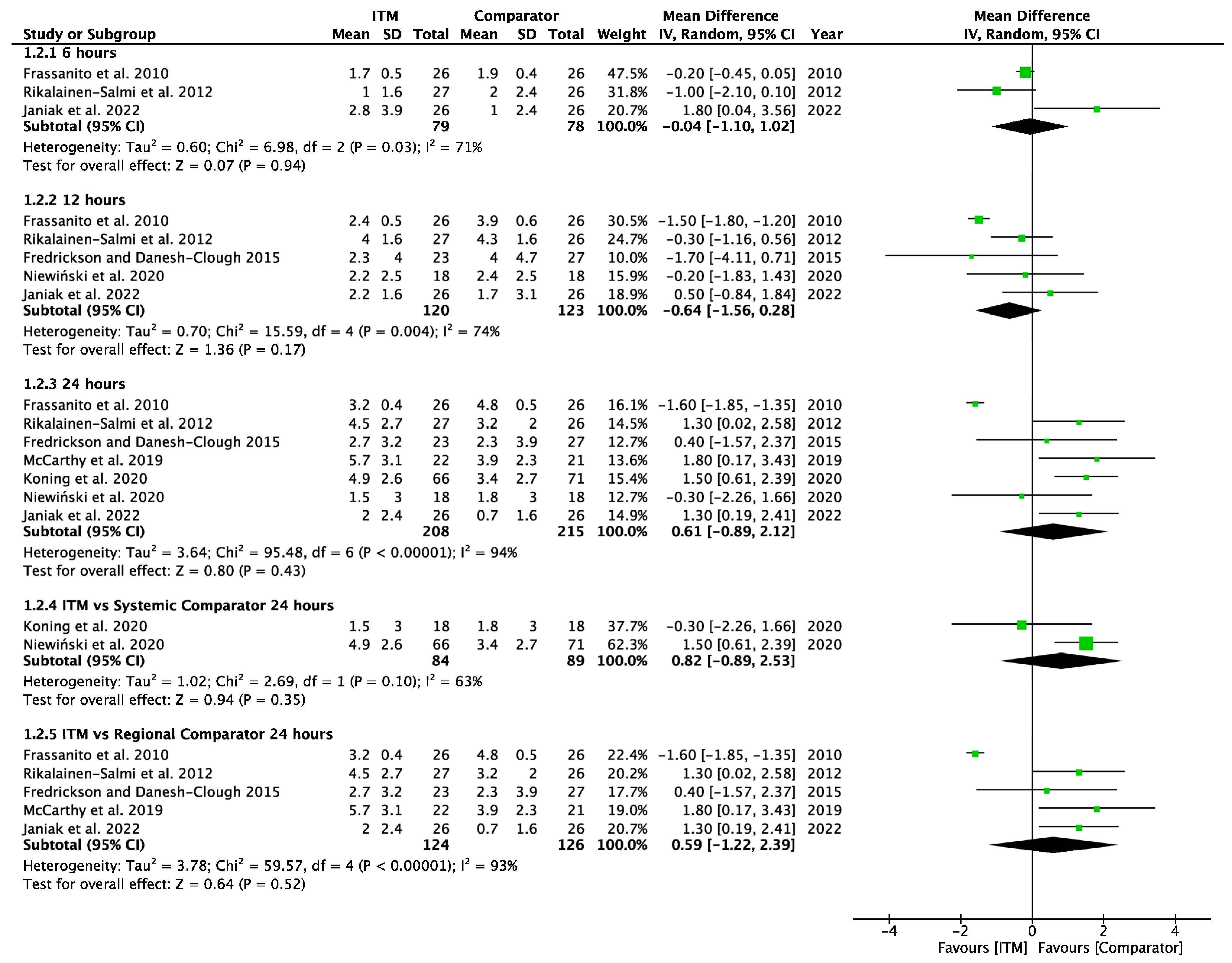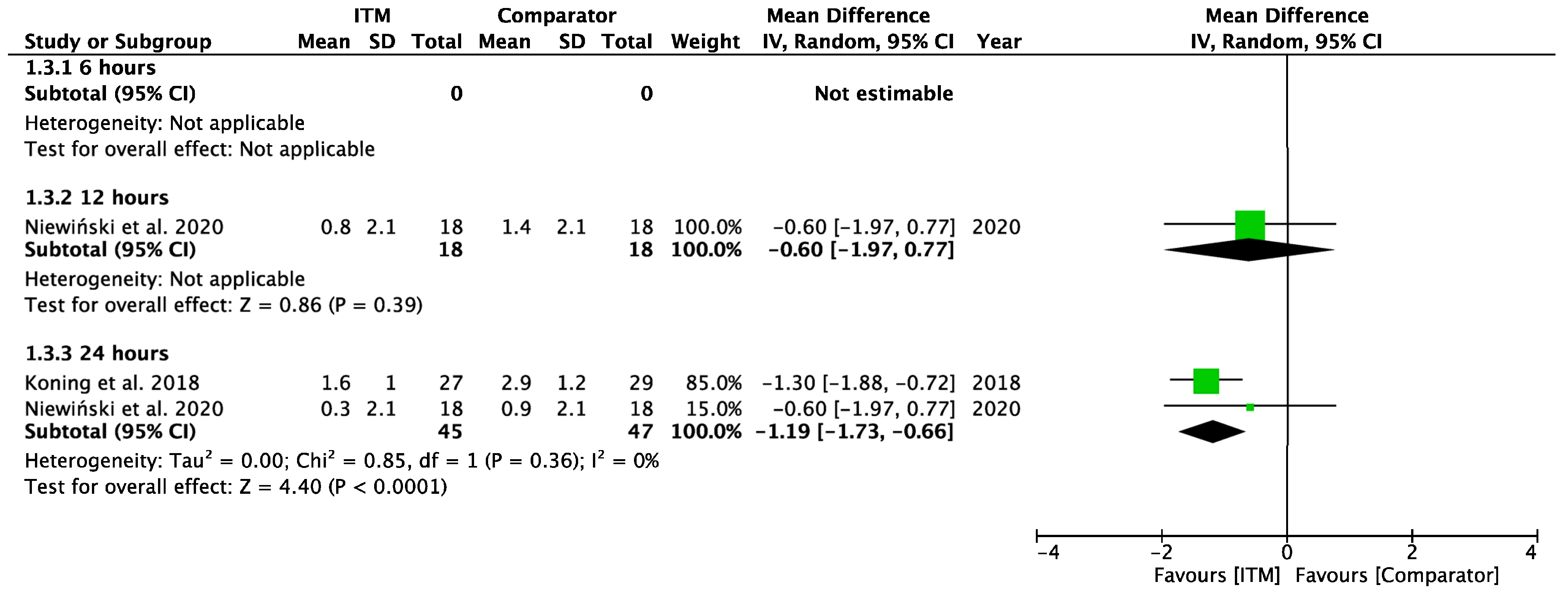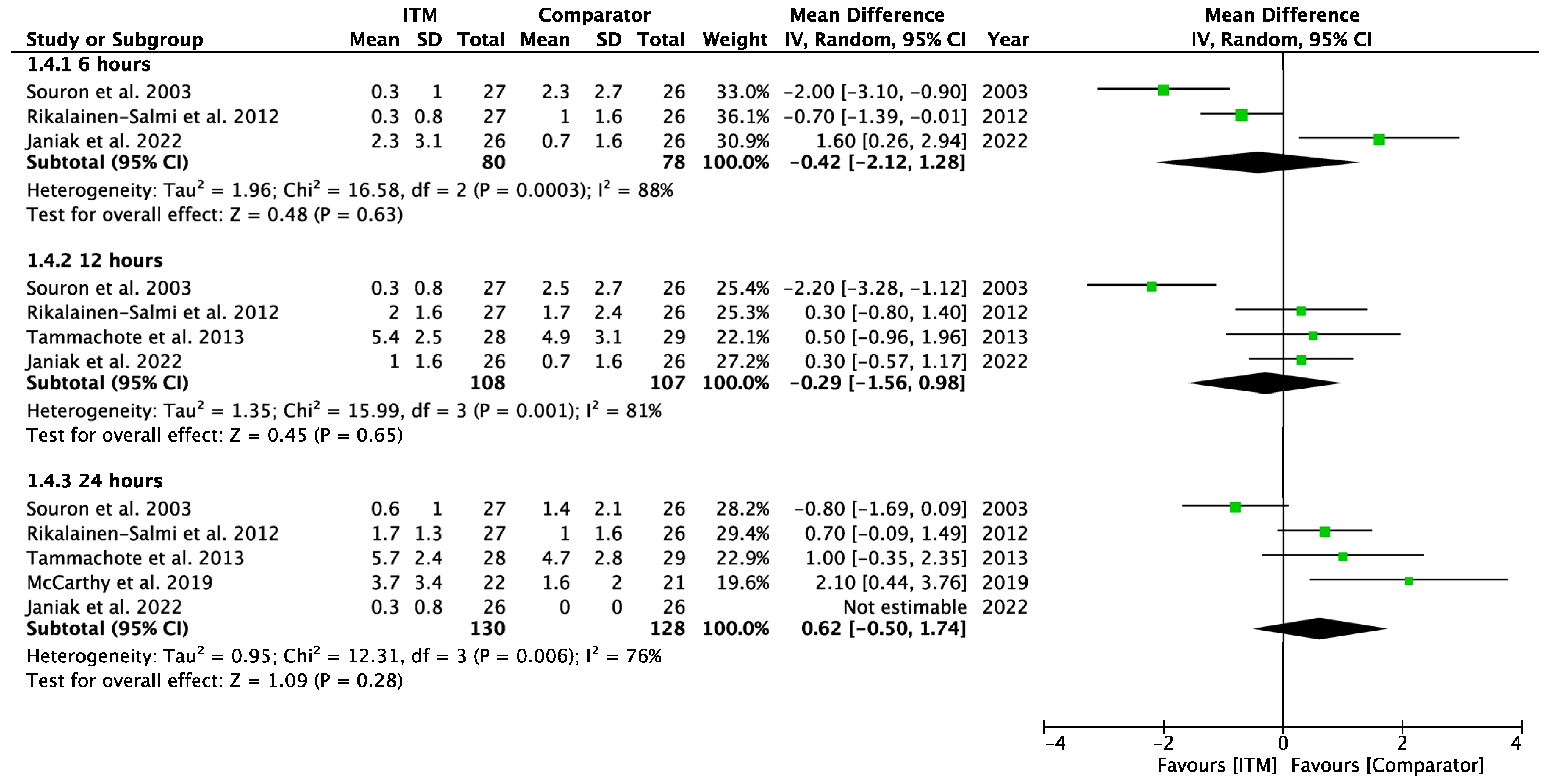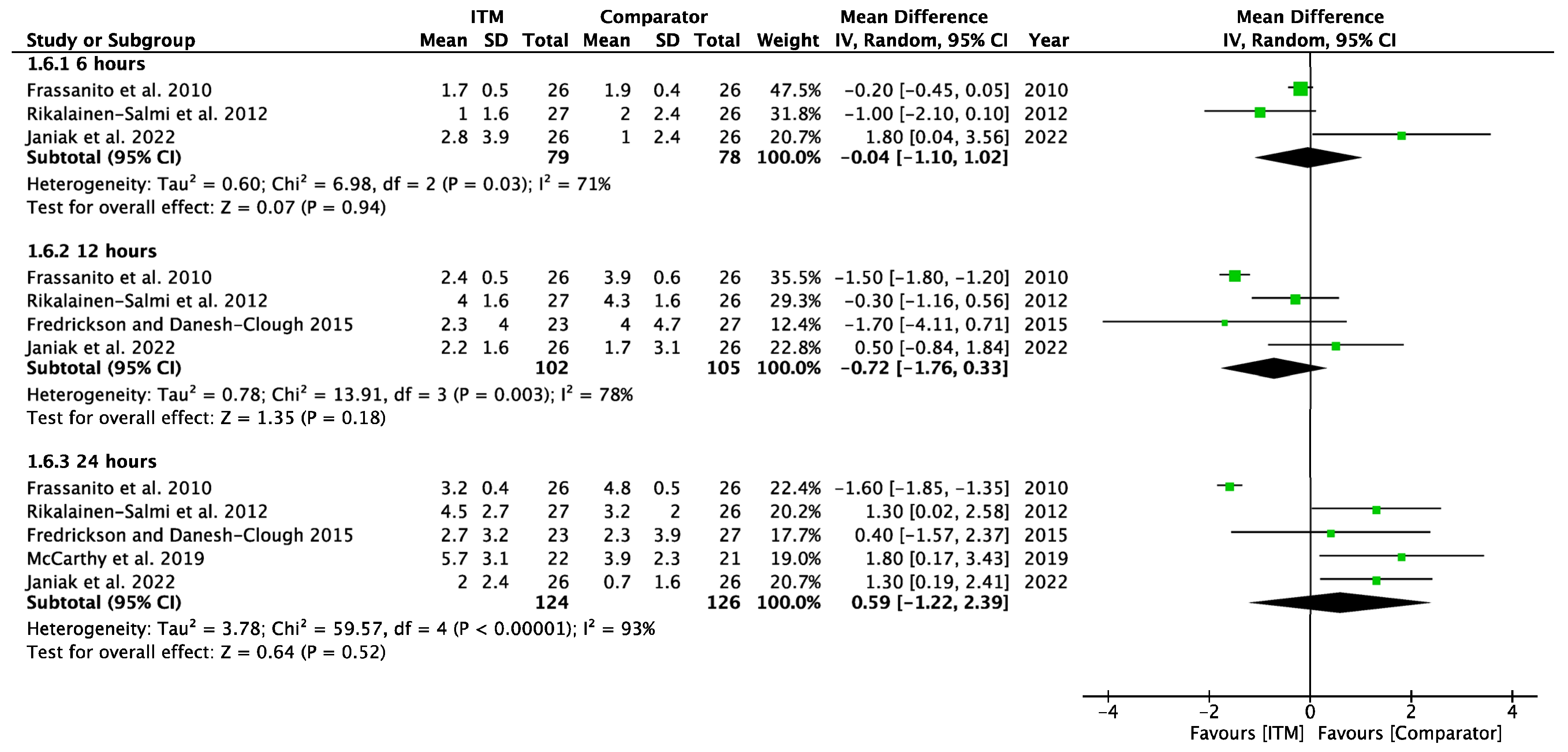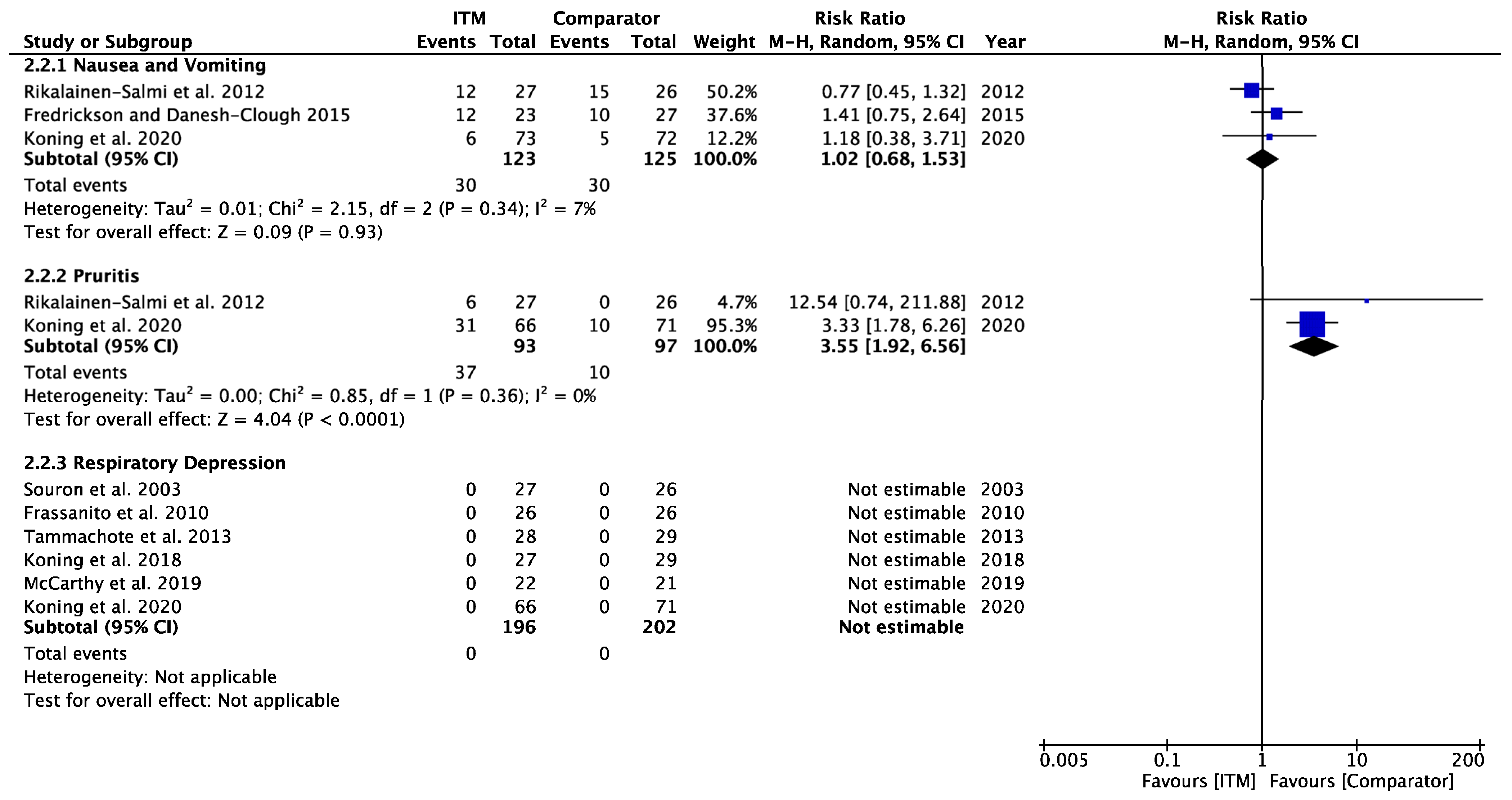Intrathecal Morphine Versus Other Techniques for Postoperative Pain Management in the Context of Multimodal Analgesia: A Meta-Analysis
Abstract
1. Introduction
2. Methods
3. Results
3.1. Primary Outcome
3.2. Secondary Outcome—Cumulative Opioid Consumption
3.3. Secondary Outcome—Opioid-Related Side Effects (Appendix A.9)
3.4. Risk of Bias and Quality Assessment
4. Discussion
Supplementary Materials
Funding
Conflicts of Interest
Appendix A
Appendix A.1
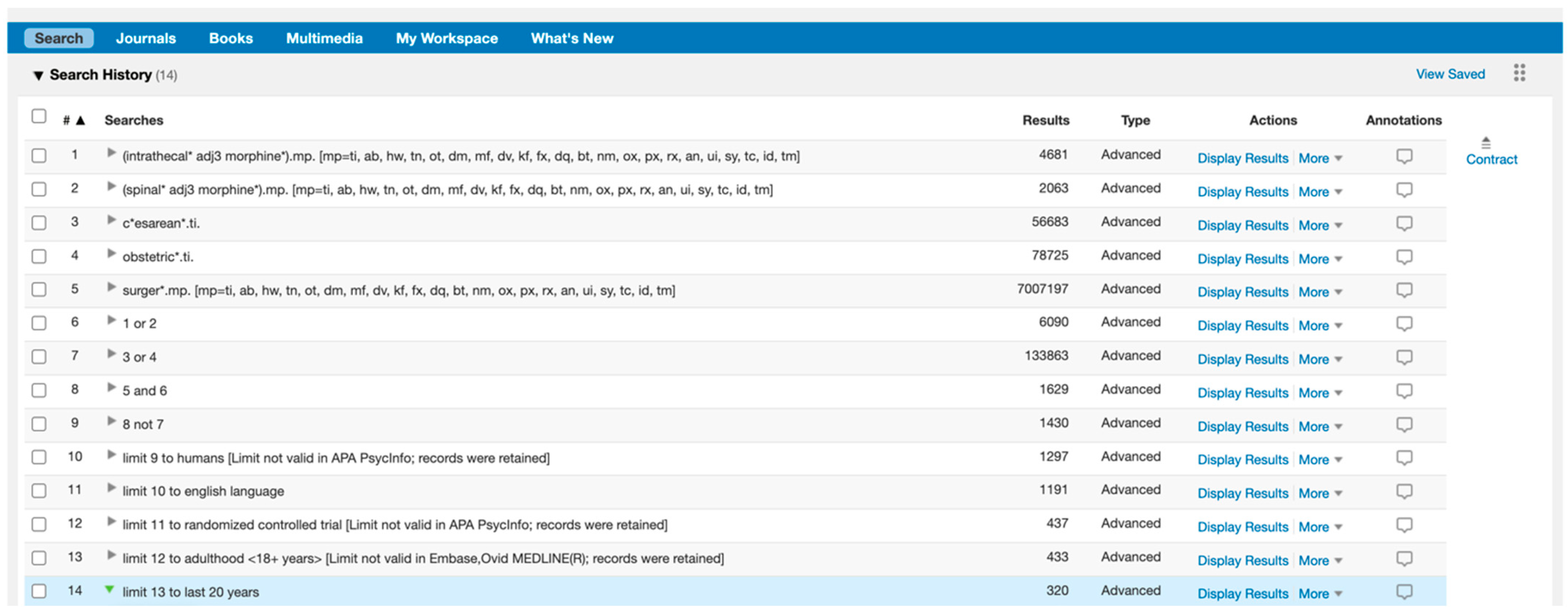
Appendix A.2
Appendix A.3
Appendix A.4
Appendix A.5
Appendix A.6
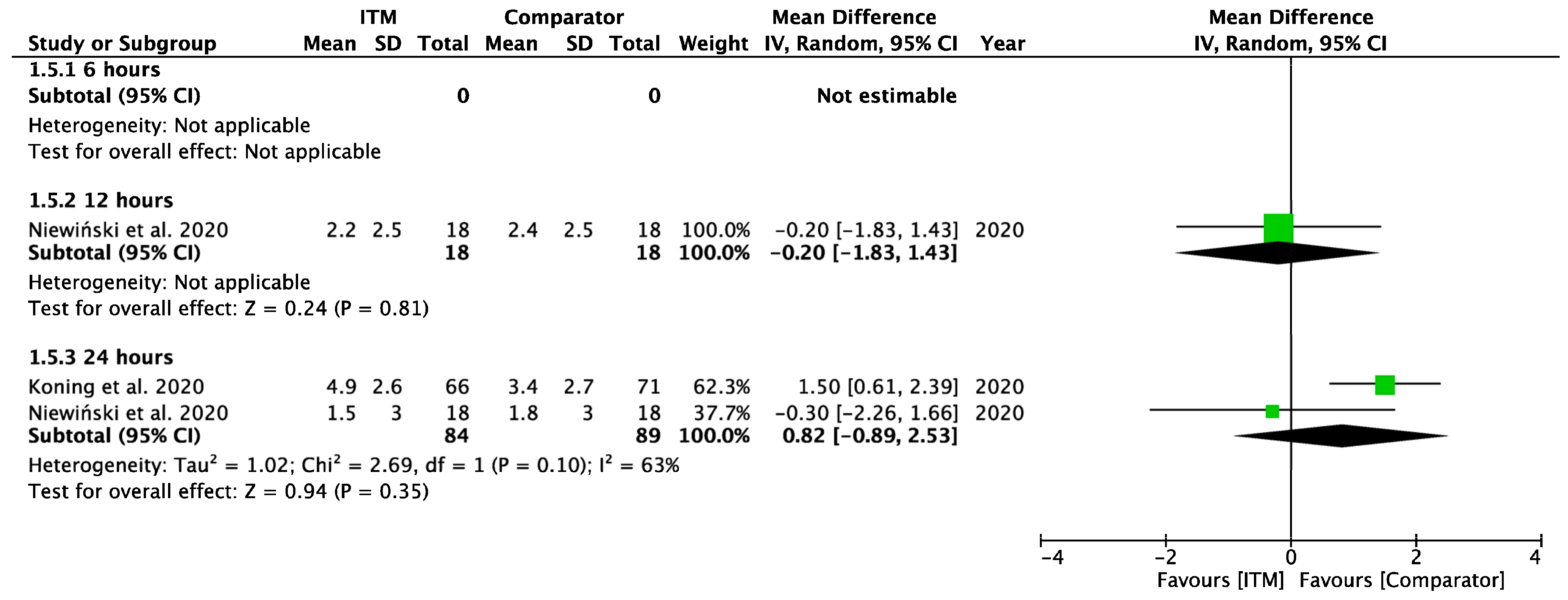
Appendix A.7
Appendix A.8
Appendix A.9
References
- Martin, P.; PQIP Project Team. Perioperative Quality Improvement Programme Report 3: August 2019–July 2021; Royal College of Anaesthetists: London, UK, 2021; pp. 21–22. [Google Scholar]
- Rathmell, J.P.; Lair, T.R.; Nauman, B. The Role of Intrathecal Drugs in the Treatment of Acute Pain. Anesth. Analg. 2005, 101, 30–43. [Google Scholar] [CrossRef] [PubMed]
- Gonvers, E.; El-Boghdadly, K.; Grape, S.; Albrecht, E. Efficacy and safety of intrathecal morphine for analgesia after lower joint arthroplasty: A systematic review and meta-analysis with meta-regression and trial sequential analysis. Anaesthesia 2021, 76, 1648–1658. [Google Scholar] [PubMed]
- Brinck, E.C.; Tiippana, E.; Heesen, M.; Bell, R.F.; Straube, S.; Moore, R.A.; Kontinen, V. Perioperative intravenous ketamine for acute postoperative pain in adults. Cochrane Database Syst. Rev. 2018, 12, CD012033. [Google Scholar] [CrossRef] [PubMed]
- Roofthooft, E.; Joshi, G.; Rawal, N.; Van de Velde, M. PROSPECT guideline for elective caesarean section: Updated systematic review and procedure-specific postoperative pain management recommendations. Anaesthesia 2020, 76, 665–680. [Google Scholar]
- Wilkinson, P.; Srivastava, D.; Bastable, R.; Carty, S.; Harrop-Griffiths, W.; Hill, S.; Levy, N.; Rocket, M.; Knaggs, R.; Randle, H.; et al. Surgery and Opioids: Best Practice Guidelines 2021; Faculty of Pain Medicine: Melbourne, Australia, 2021; pp. 5–12. [Google Scholar]
- National Institute for Health and Care Excellence (NICE). Analgesia-Mild-to-Moderate Pain. 2021. Available online: https://cks.nice.org.uk/topics/analgesia-mild-to-moderate-pain/ (accessed on 26 March 2025).
- Page, M.; McKenzie, J.; Bossuyt, P.; Boutron, I.; Hoffmann, T.C.; Mulrow, C.D.; Shamseer, L.; Tetzlaff, J.M.; Akl, E.A.; Brennan, S.E.; et al. The Prisma 2020 statement: An updated guideline for reporting systematic reviews. BMJ 2021, 372, n71. [Google Scholar]
- Joshi, G.P.; Van de Velde, M.; Kehlet, H.; PROSPECT Working Group Collaborators. Development of evidence-based recommendations for procedure-specific pain management: PROSPECT methodology. Anaesthesia 2019, 74, 1298–1304. [Google Scholar]
- Huwaldt, J.A.; PlotDigitizer. PlotDigitizer Online App. Version 2.6.9. 2021. Available online: https://plotdigitizer.sourceforge.net/ (accessed on 20 March 2023).
- Aydin, O.; Yassikaya, M.Y. Validity and Reliability Analysis of the PlotDigitizer Software Program for Data Extraction from Single-Case Graphs. Perspect. Behav. Sci. 2021, 45, 239–257. [Google Scholar]
- Wan, X.; Wang, W.; Liu, J.; Tong, T. Estimating the sample mean and standard deviation from the sample size, median, range and/or interquartile range. BMC Med. Res. Methodol. 2014, 14, 135. [Google Scholar]
- Higgins, J.P.; Li, T.; Deeks, J.J. Chapter 6: Choosing effect measures and computing estimates of effect. In Cochrane Handbook for Systematic Reviews of Interventions; Wiley: Hoboken, NJ, USA, 2022; Volume 6, p. 3. [Google Scholar]
- Fredrickson, M.J.; Danesh-Clough, T. Spinal anaesthesia with adjunctive intrathecal morphine versus continuous lumbar plexus blockade: A randomised comparison for analgesia after hip replacement. Anaesth. Intensive Care 2015, 43, 449–453. [Google Scholar]
- Rikalainen-Salmi, R.; Forster, J.G.; Makela, K.; Virolainen, P.; Leino, K.A.; Pitkänen, M.T.; Neuvonen, P.J.; Kuusniemi, K.S. Local infiltration analgesia with levobupivacaine compared with intrathecal morphine in total hip arthroplasty patients. Acta Anaesthesiol. Scand. 2012, 56, 695–705. [Google Scholar]
- Schünemann, H.J.; Higgins, J.P.; Vist, G.E.; Glasziou, P.; Akl, E.A.; Skoetz, N.; Guyatt, G.H. Chapter 14: Completing ‘Summary of findings’ tables and grading the certainty of the evidence. In Cochrane Handbook for Systematic Reviews of Interventions; Wiley: Hoboken, NJ, USA, 2022; Volume 6, p. 3. [Google Scholar]
- Evidence Prime. GRADEpro Guideline Development Tool; McMaster University: Hamilton, ON, USA, 2022. [Google Scholar]
- Deeks, J.J.; Higgins, J.P.; Altman, D.G. Chapter 10: Analysing data and undertaking meta-analyses. In Cochrane Handbook for Systematic Reviews of Interventions; Wiley: Hoboken, NJ, USA, 2022; Volume 6, p. 3. [Google Scholar]
- Sterne, J.A.C.; Savović, J.; Page, M.J.; Elbers, R.G.; Blencowe, N.S.; Boutron, I.; Cates, C.J.; Cheng, H.Y.; Corbett, M.S.; Eldridge, S.M.; et al. RoB 2: A revised tool for assessing risk of bias in randomised trials. BMJ 2019, 366, 1756–1833. [Google Scholar]
- Carlisle, J. Systematic reviews: How they work and how to use them. Anaesthesia 2007, 62, 702–707. [Google Scholar] [PubMed]
- Manager (RevMan) [Computer Program]; Version 5.4; The Cochrane Collaboration: London, UK, 2020.
- Olive, D.J.; Barrington, M.J.; Simone, S.A.; Kluger, R. A randomised controlled trial comparing three analgesia regimens following total knee joint replacement: Continuous femoral nerve block, intrathecal morphine or both. Anaesth. Intensive Care 2015, 43, 454–460. [Google Scholar] [PubMed]
- Souron, V.; Delaunay, L.; Schifrine, P. Intrathecal morphine provides better postoperative analgesia than psoas compartment block after primary hip arthroplasty. Can. J. Anesth. 2003, 50, 574–579. [Google Scholar]
- Frassanito, L.; Vergari, A.; Zanghi, F.; Messina, A.; Bitondo, M.; Antonelli, M. Post-operative analgesia following total knee arthroplasty: Comparison of low-dose intrathecal morphine and single-shot ultrasound-guided femoral nerve block: A randomized, single blinded, controlled study. Eur. Rev. Med. Pharmacol. Sci. 2010, 14, 589–596. [Google Scholar]
- Tammachote, N.; Kanitnate, S.; Manuwong, S.; Yakumpor, T.; Panichkul, P. Is pain after TKA better with periarticular injection or intrathecal morphine? Clin. Orthop. Relat. Res. 2013, 471, 1992–1999. [Google Scholar]
- Koning, M.V.; Teunissen, A.J.W.; van der Harst, E.; Ruijgrok, E.J.; Stolker, R.J. Intrathecal Morphine for Laparoscopic Segmental Colonic Resection as Part of an Enhanced Recovery Protocol: A Randomized Controlled Trial. Reg. Anesth. Pain Med. 2018, 43, 166–173. [Google Scholar]
- McCarthy, D.; McNamara, J.; Galbraith, J.; Loughnane, F.; Shorten, G.; Iohom, G. A comparison of the analgesic efficacy of local infiltration analgesia vs. intrathecal morphine after total knee replacement: A randomised controlled trial. Eur. J. Anaesthesiol. 2019, 36, 264–271. [Google Scholar]
- Niewiński, G.; Figiel, W.; Grąt, M.; Morawski, M.; Patkowski, W.; Zieniewicz, K. A Comparison of Intrathecal and Intravenous Morphine for Analgesia After Hepatectomy: A Randomized Controlled Trial. World J. Surg. 2020, 44, 2340–2349. [Google Scholar]
- Koning, M.V.; de Vlieger, R.; Teunissen, A.J.W.; Gan, M.; Ruijgrok, E.J.; de Graaff, J.C.; Koopman, J.S.H.A.; Stolker, R.J. The effect of intrathecal bupivacaine/morphine on quality of recovery in robot-assisted radical prostatectomy: A randomised controlled trial. Anaesthesia 2020, 75, 599–608. [Google Scholar]
- Janiak, M.; Kowalczyk, R.; Gorniewski, G.; Olczyk-Miiller, K.; Kowalski, M.; Nowakowski, P.; Trzebicki, J. Efficacy and Side Effect Profile of Intrathecal Morphine versus Distal Femoral Triangle Nerve Block for Analgesia following Total Knee Arthroplasty: A Randomized Trial. J. Clin. Med. 2022, 11, 6945. [Google Scholar] [CrossRef] [PubMed]
- Gehling, M.; Tryba, M. Risks and side-effects of intrathecal morphine combined with spinal anaesthesia: A meta-analysis. Anaesthesia 2009, 64, 643–651. [Google Scholar] [PubMed]
- Koning, M.V.; Klimek, M.; Rijs, K.; Stolker, R.J.; Heesen, M.A. Intrathecal hydrophilic opioids for abdominal surgery: A meta-analysis, meta-regression, and trial sequential analysis. Br. J. Anaesth. 2020, 125, 358–372. [Google Scholar] [PubMed]
- MacIntyre, P.E.; Loadsman, J.A.; Scott, D.A. Opioids, ventilation and acute pain management. Anaesth. Intensive Care 2011, 39, 545–558. [Google Scholar]


| Primary Outcome | Mean Difference [95% CI] | p-Value | I2 (p-Value) | n [Studies] | GRADE EXPLANATION |
|---|---|---|---|---|---|
| Postoperative pain at rest at 6 h | −0.42 [−2.12, 1.28] | 0.63 | 88% (<0.001) | 158 [3] | Very low ⊕⊖⊖⊖ a,b,c |
| Postoperative pain at rest at 12 h | −0.35 [−1.38, 0.68] | 0.51 | 75% (0.003) | 251 [5] | Low ⊕⊕⊖⊖ a |
| Postoperative pain at rest at 24 h | 0.07 [−0.93, 1.07] | 0.89 | 84% (<0.001) | 350 [7] | Low ⊕⊕⊖⊖ a |
| Postoperative pain on movement at 6 h | −0.04 [−1.10, 1.02] | 0.94 | 71% (0.03) | 157 [3] | Very low ⊕⊖⊖⊖ b,c,d |
| Postoperative pain on movement at 12 h | −0.64 [−1.56, 0.28] | 0.17 | 74% (0.004) | 243 [5] | Low ⊕⊕⊖⊖ b,d |
| Postoperative pain on movement at 24 h | 0.61 [−0.89, 2.12] | 0.43 | 94% (<0.001) | 423 [7] | Very low ⊕⊖⊖⊖ a,b,e |
| Secondary Outcomes | Mean Difference [95% CI] | p-Value | I2 (p-Value) | n [Studies] | GRADE EXPLANATION |
| Opioid consumption (mg) 24 h postoperatively | −11.61 [−18.73, −4.50] | 0.001 | 95% (<0.001) | 298 [4] | Very low ⊕⊖⊖⊖ a,e |
| Time to mobilisation (hours) | Insufficient number of eligible studies. | ||||
| Secondary Outcomes | Risk Ratio [95% CI] | p-Value | I2 (p-Value) | n [Studies] | GRADE EXPLANATION |
| Nausea and vomiting: incidence 24 h postoperatively | 1.02 [0.68, 1.53] | 0.93 | 7% (0.34) | 248 [3] | Low ⊕⊕⊖⊖ e |
| Pruritus: incidence 24 h postoperatively | 3.55 [1.92, 6.56] | <0.001 | 0% (0.36) | 190 [2] | Very low ⊕⊖⊖⊖ c,e |
| Respiratory depression: incidence 24 h postoperatively | Not estimable. | ||||
| Reference | Locations | Surgery | Mean Age (SD) | Gender Ratio (M/F) | ITM Dose | Active Comparator | Spinal Anaesthesia | Post-OP Multi-Modal Analgesia |
|---|---|---|---|---|---|---|---|---|
| Souron et al., 2003 [23] | France | Primary hip arthroplasty | ITM = 66.8 (13.1) C = 67.7 (12) | ITM = 12/14 C = 9/18 | 100 µg | Psoas-compartment block | n/a | IV paracetamol IV ketoprofen |
| Frassanito et al., 2012 [24] | Italy | Total knee arthroplasty | ITM = 67.4 (8.5) C = 68 (5.8) | ITM = 19/6 C = 14/12 | 100 µg | Single-shot ultrasound guided femoral nerve block | Bupivacaine 15 mg | IV paracetamol IV ketorolac |
| Rikalainen-Salmi et al., 2012 [15] | Finland | Total hip arthroplasty | ITM = 66 (6.3) LIA = 65 (8.7) | ITM = 11/17 C =10/19 | 100 µg | Local infiltration analgesia | Bupivacaine 16 mg | PO paracetamol PO ibuprofen |
| Tammachote et al., 2012 [25] | Thailand | Total knee arthroplasty | ITM = 69 (8) C = 70 (7) | ITM = 8/20 C =3/26 | 200 µg | Periarticular multimodal drug injection | 0.5% bupivacaine 2.5 mL | Paracetamol Amitriptyline Naproxen |
| Olive et al., 2015 [22] | Australia | Total knee joint replacement | ITM = 70.6 C = 70.3 | ITM = 10/17 C = 12/16 | 1750 µg | Continuous femoral nerve block | 0.5% bupivacaine 3.5 mL | PO paracetamol PO celecoxib |
| Fredrickson and Danesh-Clough, 2015 [14] | New Zealand | Total hip joint replacement | ITM =62.6 (9.4) C = 63.2 (7.2) | ITM = 9/14 C =12/15 | 100 µg | Patient controlled continuous femoral nerve bock | 0.5% bupivacaine 2 mL (ITM only) | PO paracetamol PO diclofenac (sustained release) |
| Koning et al., 2018 [26] | Netherlands | Laparoscopic segmental colonic resection | ITM = 66.1 (7.8) C = 67.9 (11.1) | ITM = 18/9 C = 15/14 | 300 µg (240 µg if >70 yo) | IV piritramide bolus | Bupivacaine 12.5 mg; or 10 mg if age >75 (ITM only) | Paracetamol Metamizole |
| McCarthy et al., 2019 [27] | Ireland | Total knee arthroplasty | ITM = 64.3 (8.9) C = 66.0 (9.8 | ITM = 12/10 C = 12/9 | 300 µg | Local infiltration analgesia | 0.5% bupivacaine 15 mg if <70 kg BW; 17.5 mg if >70 kg BW | PO paracetamol PO diclofenac sodium |
| Niewiński et al., 2020 [28] | Poland | Hepatectomy | ITM = 60 (10.5) C = 55 (12.1) | ITM = 9/9 C = 6/12 | 400 µg | IV morphine bolus | n/a | Paracetamol Dexketoprofen |
| Koning et al., 2020 [29] | Netherlands | Robot-assisted radical prostatectomy | ITM = 66 (5.6) C = 65.3 (7.8) | ITM = 66/0 C = 71/0 | 300 µg | IV morphine bolus | Bupivacaine 12.5 mg (ITM only) | IV paracetamol IV metamizole |
| Janiak et al., 2022 [30] | Poland | Total knee arthroplasty | ITM = 68 (11.9) C = 67.5 (9.7) | ITM = 23/3 C =23/3 | 100 µg | Single-shot femoral nerve block | 0.5% bupivacaine 15 mg | IV paracetamol IV ketoprofen |
Disclaimer/Publisher’s Note: The statements, opinions and data contained in all publications are solely those of the individual author(s) and contributor(s) and not of MDPI and/or the editor(s). MDPI and/or the editor(s) disclaim responsibility for any injury to people or property resulting from any ideas, methods, instructions or products referred to in the content. |
© 2025 by the authors. Licensee MDPI, Basel, Switzerland. This article is an open access article distributed under the terms and conditions of the Creative Commons Attribution (CC BY) license (https://creativecommons.org/licenses/by/4.0/).
Share and Cite
Gibson, A.W.; Cooper, N.E.; Albrecht, E.; Forget, P. Intrathecal Morphine Versus Other Techniques for Postoperative Pain Management in the Context of Multimodal Analgesia: A Meta-Analysis. Pharmaceuticals 2025, 18, 512. https://doi.org/10.3390/ph18040512
Gibson AW, Cooper NE, Albrecht E, Forget P. Intrathecal Morphine Versus Other Techniques for Postoperative Pain Management in the Context of Multimodal Analgesia: A Meta-Analysis. Pharmaceuticals. 2025; 18(4):512. https://doi.org/10.3390/ph18040512
Chicago/Turabian StyleGibson, Arron W., Niamh E. Cooper, Eric Albrecht, and Patrice Forget. 2025. "Intrathecal Morphine Versus Other Techniques for Postoperative Pain Management in the Context of Multimodal Analgesia: A Meta-Analysis" Pharmaceuticals 18, no. 4: 512. https://doi.org/10.3390/ph18040512
APA StyleGibson, A. W., Cooper, N. E., Albrecht, E., & Forget, P. (2025). Intrathecal Morphine Versus Other Techniques for Postoperative Pain Management in the Context of Multimodal Analgesia: A Meta-Analysis. Pharmaceuticals, 18(4), 512. https://doi.org/10.3390/ph18040512






